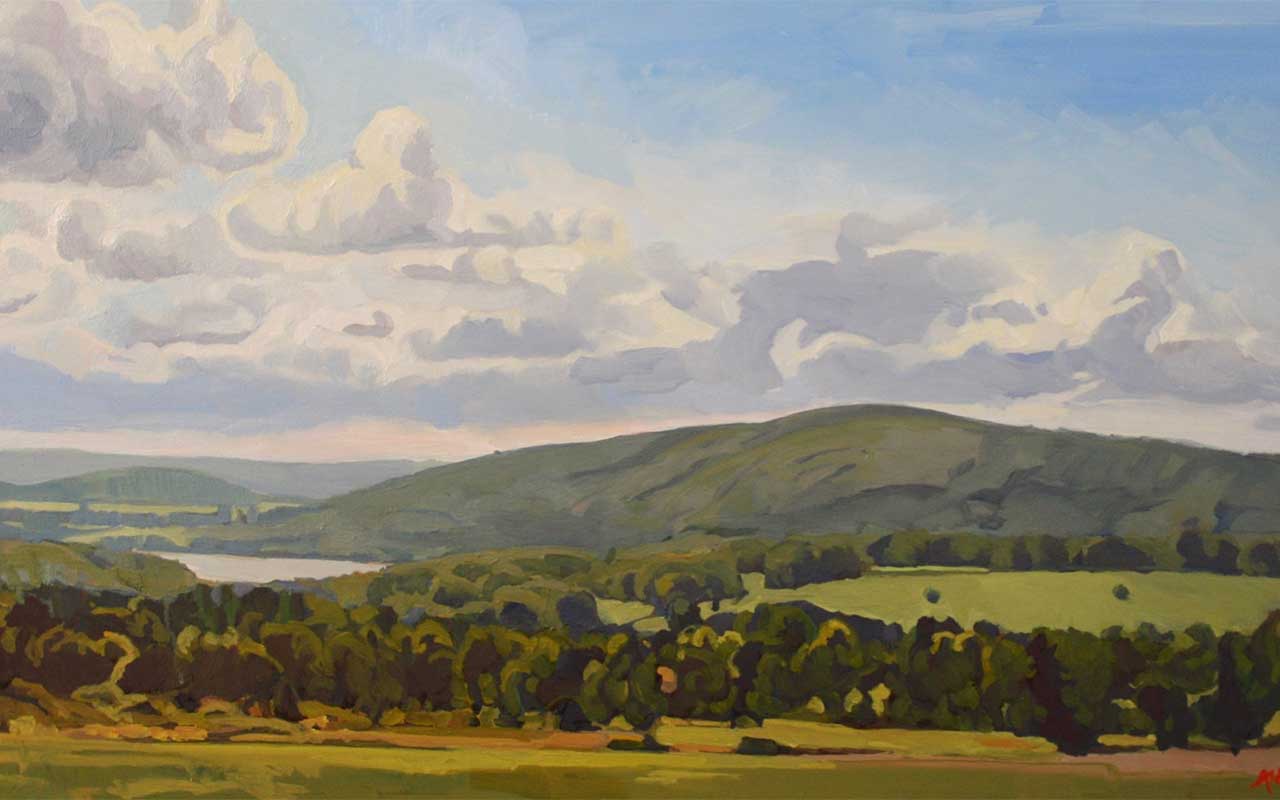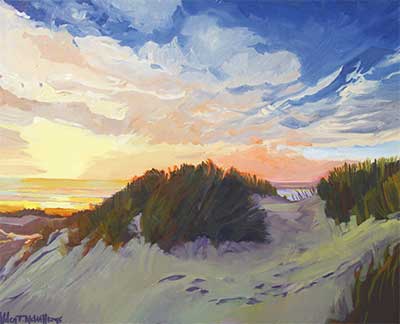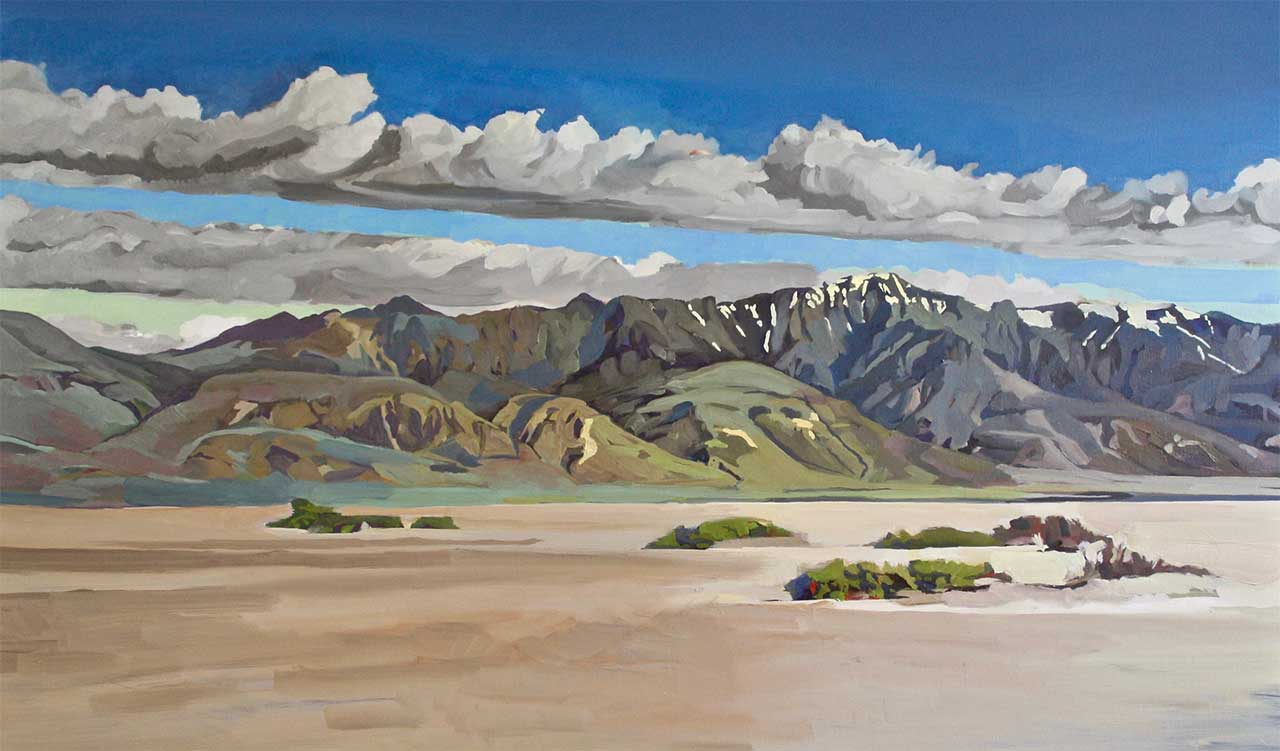Featured Artist

Alden “Trevor” McWilliams
Alden “Trevor” McWilliams grew up as a faculty child on the Millbrook School campus in Millbrook, NY. His artistic expression was influenced by his grandfather, a professional illustrator, as well as his father who taught photography, drawing, and printmaking. Trevor’s love for the visual arts was solidified on trips to New York City’s museums, viewing atmospheric Hudson River School masterpieces, and studying drawing and painting under Millbrook’s longtime art director, painter, and mentor, Bill Hardy, from 1997-2001.
After studying English and Art at Colby College, in Waterville, ME, Trevor worked at the Williston Northampton School in Easthampton, MA, from 2005-2008. In search of experiences beyond academia, Trevor traveled throughout parts of Europe, Southeast Asia, and the United States before settling in Portland, OR, in 2009. There, Trevor engaged firsthand with the region’s mystifying landscape, often exploring parts of the Cascade Mountains that many never see, which directly influenced his artistic focus. After Trevor committed to painting landscapes, a local Millbrook painter and dear family friend, Peter Corbin, generously opened his studio door for a traditional oil painting apprenticeship in the winter of 2011 that continued intermittently over the next ten years.
 After 13 years in Oregon, Trevor decided it was time to return to his roots and recently relocated back home to Dutchess County. He spends his time enjoying and painting the beautiful regions of New York’s Hudson Valley and New England. And it was here that we were able to catch up with him and talk about his art.
After 13 years in Oregon, Trevor decided it was time to return to his roots and recently relocated back home to Dutchess County. He spends his time enjoying and painting the beautiful regions of New York’s Hudson Valley and New England. And it was here that we were able to catch up with him and talk about his art.
Can you describe the type of work you do and the mediums you use?
Landscape currently serves as the primary source of inspiration for my work. I attempt to transmit my own emotional interpretations of Nature’s grandeur through drawing and painting, accentuating earth’s noble gestures as I traverse her wild spaces. While these expressions are deeply personal, my perpetual aim is to share these moments inside sweeps of solitude with the viewer in the hopes of connecting us. I wish for the mood and atmosphere of a moment to be just as recognizable to someone else as the place itself, if not more, and for my work to touch their feelings in a way that resonates and lasts.
I paint in oils, typically on canvas, paper, and occasionally wood panel. I draw with graphite, charcoal, pastel, or pen, ink and ink wash, depending upon my mood, the subject matter, or drafting phase.
How do you develop your art skills?
I try to spend as much time as possible in the field exploring my subjects, wandering, waiting to see the full range of light, and working from life. However, when the winter returns, I retreat to the studio and tackle larger canvases by way of studies, references, and impressions gathered in preparation.
Every facet of my technical practice is equally integral to my artistic development. From the thumbnail sketches to preliminary drawings, color studies to finished paintings, each phase of observation and rendering feeds the next. All stages require honing by way of consistent practice and attention.
Looking at the work of other artists who I admire is always critical for my own development. I draw tremendous inspiration from the life and work of heroes past and present whose work speaks to me.
Who are your biggest artistic influences?
George Bellows, Thomas Hart Benton, Albert Bierstadt, Russell Chatham, Richard Diebenkorn, Maynard Dixon, Bill Gallen, Edward Hopper, Wolf Kahn, Alice Neel, Georgia O’Keefe, Fairfield Porter, James Prosek, Jacob van Ruisdael, John Singer Sargent, Andrew Wyeth – and from those I drew inspiration from their words:
“Interest is the most important thing in life; happiness is temporary, but interest is continuous.” –Georgia O’Keeffe
“I was never one to paint space, I paint air.” –Fairfield Porter
“I think one’s art goes as far and as deep as one’s love goes. I see no reason for painting but that. If I have anything to offer, it is my emotional contact with the place where I live and the people I do.” –Andrew Wyeth
How did where you grew up affect your work?
My sense of place and love of Nature was ingrained early on growing up in the Hudson Valley. As a young faculty child, I traversed the fields and forests of the Millbrook School campus on a daily basis, noting the subtlest and most dramatic of changes through the seasons. I am enormously fortunate to have grown up within a community that encouraged us all to wander freely, explore our interests, and beg questions of the students, faculty, and place alike.
In addition to the immediate surroundings of Millbrook and the bucolic Hudson Valley, I relished the opportunity to visit the region’s museums with my family or on school field trips to view historic works of Art in person. New York’s institutions such as The Metropolitan Museum of Art, MoMA, The Guggenheim, Storm King Arts Center, or The Clark, and MASS MoCA over the Massachusetts border (just to name a few) reminded me again and again that I was growing up in an international artistic epicenter. My exposure to these collections and spaces at such a young age and beyond remains undeniably paramount and profoundly influential to my creative foundation and pursuits.
Why did you decide to move to Oregon and why did you decide to move back east?
I originally left the Northeast in search of fresh experiences, high adventure, and change. The largest concentration of friends who I love and admire out west live in Oregon to this day, and I followed their lead to Portland after visiting one too many times. I was quickly immersed in a brand new way of life, one filled with thrilling passions and seasonal employment that intimately connected me with the region’s mystifying landscape and creative culture. In many ways, Oregon and Washington introduced me to myself and eventually my own artistic expression. For all of these reasons, a huge part of my grateful heart and soul will always reside in the rivers, alpine lakes, and Cascade Mountains of the Pacific Northwest.
Despite my love for the life I created in Oregon, I always sensed that I would return to the east coast one day to be closer to my family. I just didn’t know when that day would come, that is until I attended my grandmother, Beverly “Grey” Seward’s Memorial service on Cape Cod this spring, where the urgency became all the more real to me. During that same trip, I began seeing something new in these pastoral scenes throughout the Mid-Hudson Valley, Cape Cod, and parts of New England that took me by surprise. I felt an internal difference in light of the season’s vibrant shimmer, and the same electric charge surged through me that I’d always associated with being in the west. That profound pulsation made me want to turn my sights and brushes toward the region that raised me, and, to quote Andrew Wyeth, “find fresh meaning in something familiar.”
How is art important to society?
Art possesses the unique ability to transcend time, space, and boundaries. It provides shape to the intangible and gives a voice to voids and joys larger than comprehension within the human experience. Serving as mirror, window, and portal, art provides a vehicle for all feelings and stories to flow to, through, and out of us. Art challenges us to grow and engage with the starkest of society’s contrasts and truths of the endlessly complex, beautiful world outside of ourselves. Art saves life in the face of death, instills strength, casts light, and guides perilous journeys. And when the purest bliss lifts people to new heights, art reminds us that we are supposed to be there, too, fully alive, far from alone, and basking in the glad grace of a moment.
How do you define success as an artist?
Personally, I feel success means identifying and relentlessly engaging with the passionate interests, people, and spaces that fulfill a person at the end of the day. I believe a successful artist finds a way to infuse these critical elements within their work in a way that resonates and connects with an audience, revealing one’s authentic nature by remaining committed to the internal truths of one’s own heart.
What, besides art, brings you joy?
Above all else, spending quality, uninterrupted time connecting with my family and dear friends brings me the most joy, especially with some music and good food at hand. I am truly grateful to have so many people in my corner who love me unconditionally and inspire me in countless ways with their character and zest for living. Some friendships go back as far as my own birth, or nursery school, and each subsequent stage in my life. I wouldn’t be who I am without their influence, persistence over the years, and love.
Time spent in the wild is a very close second to time with my people, especially when some of those loved ones accompany me on a proper adventure. True wilderness brings out the best in me. Launching into extended alpine thru-hikes and traversing rugged spaces with all I need on my back makes me feel the most alive and joyful outside of reuniting with my people and creating my own art.
Beyond that a short list might include: shucking oysters (east and west coast), LP’s on vinyl, fiction, dogs, the beautiful game, scenic byways, skiing fresh powder, Talking Heads, hand-written letters, and the New York Mets. •
To learn more about Alden “Trevor” McWilliams and his work, you can visit his website at www.aldentmcwilliams.com
Are you an artist and interested in being featured in Main Street Magazine? Send a brief bio, artist’s statement, and a link to your work through the arts form on our “arts” page on our website.

